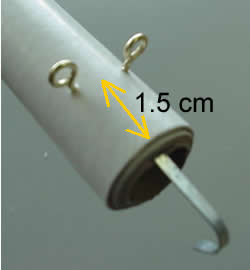|
The
launch vehicle
|
|
The launch vehicle is built
similar to a normal rocket with one major exception, it has no fins. Click
to see how a rocket is built.
|
| Build the launch
vehicle as you would a normal rocket. When it comes to preparing the engine
holder glue the spacer rings together as shown on the right before inserting
it into the body of the rocket. |
 |
| Screw in to the
body of the rocket two screw-eyes 1.5 cm from the base. The screw-eyes should
penetrate the spacer rings and be held firmly in position. Make sure the
screw-eyes do not penetrate into the engine holder. |
|
| Place the "U"
shaped wire of the glider through the screw-eyes as shown on the right. |
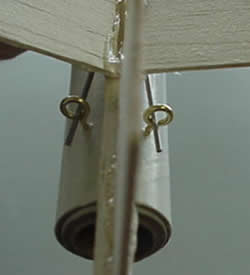 |
| Using a pencil mark the point
on the rocket that the front of the glider reaches up to. This is shown
by the yellow arrow. |
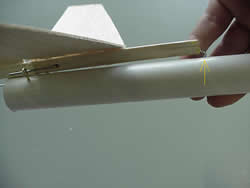 |
| At the point you have marked,
insert a third screw-eye. The screw eye can be screwed all the way into
the body of the rocket and must be perfectly aligned with the two screw-eyes
at the base of the rocket. |
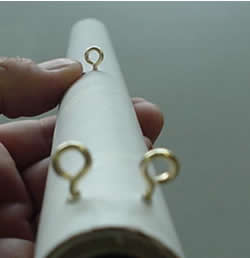 |
|
The glider is
now placed onto the rocket as shown on the right.
|
 |
Do the same for the other
glider. Notice how both gliders are at the exact height above the base
and stand directly opposite each other.
Notice the positioning of
the blue launch lug between the two gliders.
Click to see a 120kb video of the symmetry
of the finished model.
|
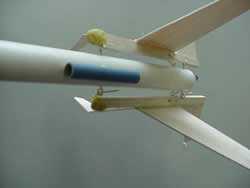 |
|
Can you see how the gliders
will be released at the apex of flight? As the parachute is released the
rocket will jerk backwards. This backward motion will release the gliders
to glide freely back to the ground.
|
| You may change the design a
little. The wings can be slightly modified as shown on the right. It is
advisable that the gliders do not exceed the dimensions specified here.
You can go smaller but not larger. The larger the model the greater the
air resistance. Air resistance causes drag forces to develop that may tear
the glider apart and make the rocket unstable. |

|
The boost gliders are ready for launch. Use an A8-3 or B6-4 engine only.. Remember that the gliders have a great deal of surface area and are susceptible to wind.
Launch on days with no wind and make sure all spectators are at least 80 m from the rocket. |
 |
| At launch a great deal of drag is experienced by the rocket as it accelerates. More drag than usual because of the greater wingspan. |
 |
When the parachute ejects the rocket will be pushed backwards by the force of the explosive charge. This will free the gliders to glide back to earth.
Timing the gliders as they descend is a good measure of the success of the group's efforts. |
 |

